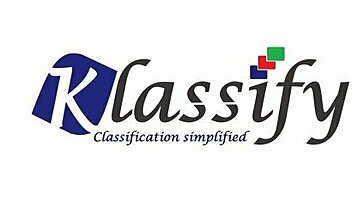3.75
Fortra’s Data Classification Suite Review
Discover Fortra’s Data Classification Suite in our review. Analyze its security features, automation, pricing, and support. See if it offers value for money!
Comprehensive overview and target audience
Comprehensive overview of Fortra’s Data Classification Suite and target audience
Fortra’s Data Classification Suite provides a robust framework for organizations seeking to identify, classify, and protect sensitive information across their digital landscape. It empowers users to apply persistent metadata labels to emails and documents, ensuring data awareness and control throughout its lifecycle. The suite integrates multiple tools designed to work seamlessly, enhancing overall data governance and reducing complexity. Key Fortra’s Data Classification Suite security features include automated policy enforcement based on content inspection and user driven classification prompts, helping prevent accidental data loss, enforce handling policies, and ensure compliance with various regulations.
The primary target audience includes organizations operating within highly regulated sectors such as finance requiring protection for customer financial data; healthcare safeguarding patient records according to HIPAA; government securing classified information; and legal services protecting client confidentiality. Businesses managing substantial amounts of intellectual property or personally identifiable information PII also find significant value in preventing data exfiltration and maintaining competitive advantage. Essentially, any enterprise needing granular control over its data lifecycle from creation to archival or disposal benefits immensely. Its scalability makes it suitable for large global enterprises coordinating policies across diverse departments and geographies, as well as for growing mid sized companies proactively establishing a strong data security posture before incidents occur.
Evaluating Fortra’s Data Classification Suite value for money requires looking beyond the initial license cost. The suite’s ability to mitigate costly breach risks, simplify and ensure regulatory compliance like GDPR or CCPA, and improve operational efficiency by integrating with other security tools contributes significantly to its return on investment. A thorough Fortra’s Data Classification Suite pricing comparison should consider the depth of features offered against competitors; Fortra often emphasizes comprehensive protection, flexible deployment options, and intuitive user experiences. Fortra demonstrates commitment through regular Fortra’s Data Classification Suite updates and new features, ensuring the platform evolves with emerging threats, compliance mandates, and user feedback, safeguarding long term investment value. Organizations also benefit from extensive Fortra’s Data Classification Suite support and training resources; these include detailed documentation, knowledge bases, online tutorials, and professional services crucial for seamless implementation, effective policy configuration, and ongoing user adoption which maximizes the technology’s impact and utility.
- Persistent classification labels applied automatically or by users ensuring consistent data handling.
- Integration capabilities with existing security infrastructure like Data Loss Prevention DLP, encryption tools, and Security Information and Event Management SIEM systems.
- Enhanced data visibility and reporting for compliance auditing and demonstrating due diligence.
- Broad support for various file types, email platforms, and operating environments including cloud storage repositories.
User experience and functional capabilities
Delving into the user experience and functional capabilities, Fortra’s Data Classification Suite generally aims for intuitive interaction. Fortra’s Data Classification Suite user experience insights often highlight the clarity of classification prompts presented to end users within familiar applications like Microsoft Office and Outlook. The goal is seamless integration into daily workflows, minimizing disruption while maximizing security awareness. Users are typically guided to select appropriate data sensitivity labels based on content or context, although automated classification significantly reduces this burden for standard document types. Understanding how to use Fortra’s Data Classification Suite effectively involves familiarizing users with these prompts and the meaning behind each classification level, which is crucial for accurate data handling.
The initial setup, often detailed in resources like a Fortra’s Data Classification Suite implementation guide, plays a vital role in shaping the long term user experience. A well configured system ensures policies are applied correctly and that prompts are relevant, not intrusive. However, some common problems with Fortra’s Data Classification Suite can arise from overly complex policy configurations or inadequate initial user training. Balancing security rigor with user productivity is key; too many prompts or overly restrictive rules can lead to user fatigue or workarounds. Careful planning during implementation, considering specific organizational needs and workflows, is therefore essential to mitigate these potential issues and foster user adoption.
Functionally, the suite offers robust capabilities beyond simple labeling. Key features include:
- Persistent metadata classification that travels with the file across its lifecycle.
- Content inspection engines for suggesting or enforcing classification automatically based on defined policies and sensitive information types.
- Comprehensive reporting and auditing capabilities providing visibility into data classification activities and supporting compliance mandates.
- User driven classification options integrated into common productivity tools, empowering users while maintaining central control.
A significant strength lies in integrating Fortra’s Data Classification Suite with other tools. This synergy enhances overall security posture; for instance, integration with Data Loss Prevention DLP solutions can block the transmission of highly classified data based on Fortra labels, while Security Information and Event Management SIEM integration centralizes monitoring and alerting. This ability to connect with existing security investments maximizes the suite’s effectiveness within a broader data protection strategy.
Fortra demonstrates a commitment to improvement through regular Fortra’s Data Classification Suite updates and new features. These updates often address evolving threats, incorporate user feedback to refine the user experience, and expand compatibility with new platforms or regulations. Staying current with these updates is important for maintaining optimal protection. Best practices for leveraging the suite include establishing clear, concise classification policies from the outset, providing thorough user training tailored to different roles, regularly reviewing classification accuracy through audits, and refining policies based on reporting insights and changing business needs. Properly implemented and managed, the suite becomes a powerful asset for data governance and security.
Who should be using Fortra’s Data Classification Suite
Fortra’s Data Classification Suite is designed for organizations that recognize the critical importance of understanding, categorizing, and protecting their data assets. Any entity handling sensitive information, facing regulatory compliance mandates, or aiming to prevent costly data breaches should consider this solution. It is particularly beneficial for businesses operating in highly regulated industries where data protection is not just a best practice but a legal requirement.
Specific sectors finding immense value include:
- Financial Services: Banks, insurance companies, and investment firms needing to protect customer financial data, account numbers, and comply with regulations like PCI DSS or GLBA.
- Healthcare: Hospitals, clinics, and insurers required to safeguard Protected Health Information PHI under HIPAA regulations.
- Government Agencies: Entities managing classified information, citizen data, and sensitive communications requiring stringent access controls and handling protocols.
- Legal Firms: Practices needing to maintain strict client confidentiality and protect privileged information.
- Technology and Manufacturing: Companies safeguarding valuable intellectual property, research and development data, and proprietary designs from theft or leakage.
Consider a typical Fortra’s Data Classification Suite use case scenario: a financial institution implementing the suite to automatically identify and label documents containing customer PII and account details. When an employee attempts to email such a document externally without proper encryption or authorization, the integrated DLP system, triggered by the Fortra classification label, can block the action, preventing a potential breach and ensuring regulatory adherence. This proactive control is essential.
Beyond specific industries, the suite is suitable for large global enterprises needing consistent policy enforcement across diverse departments and geographies, as well as for mid sized organizations seeking to establish a robust data security foundation. Organizations committed to implementing Best practices for Fortra’s Data Classification Suite, such as defining clear policies, providing user training, and integrating it effectively with their existing security ecosystem, will derive the maximum benefit. Ultimately, any organization looking to enhance data visibility, improve compliance posture, and reduce the risk associated with sensitive data handling should evaluate Fortra’s Data Classification Suite.
Unique Features offered by Fortra’s Data Classification Suite
Fortra’s Data Classification Suite stands out due to its significant flexibility and distinct capabilities designed to meet diverse organizational data protection requirements. The platform offers extensive customization options allowing businesses to precisely tailor data classification policies, labels, and user interactions to fit their specific operational workflows and compliance landscapes. You can configure classification levels, define sensitive information patterns for automated detection, customize the appearance and text of user prompts within applications, and set specific policy enforcement rules based on data sensitivity.
This adaptability is key when considering Customizing Fortra’s Data Classification Suite for business growth. As organizations expand their operations, introduce new services, or enter different regulatory environments, the suite can be reconfigured to accommodate these evolving needs, ensuring data protection strategies remain aligned with business objectives. Unique features further enhance its value. The persistent metadata classification ensures labels travel with the data across its entire lifecycle, regardless of where it is stored or shared. Its hybrid approach, blending powerful automated classification based on content inspection with intuitive user driven labeling options, provides both efficiency and accuracy, empowering users while maintaining central control.
The suite’s architecture is built for scalability. While robust enough for large enterprises, its customization means it can also be effectively configured for smaller organizations. This makes Fortra’s Data Classification Suite for small businesses a viable option, allowing them to implement strong data governance without the complexity often associated with enterprise grade solutions. Another standout capability involves Integrating Fortra’s Data Classification Suite with other tools. It seamlessly connects with existing security infrastructure components such as Data Loss Prevention systems, encryption technologies, Security Information and Event Management platforms, and identity management solutions. This integration creates a cohesive security ecosystem where classification labels trigger appropriate actions within other tools, significantly strengthening overall data protection and response capabilities.
- Tailored classification policies and labels matching specific business needs.
- Customizable user prompts for seamless integration into workflows.
- Persistent metadata ensuring lifelong data awareness and control.
- Hybrid classification blending automation and user input for flexibility.
- Robust reporting providing deep visibility into data landscape and compliance posture.
- Seamless integration capabilities enhancing the broader security infrastructure.
Pain points that Fortra’s Data Classification Suite will help you solve
Many organizations grapple with significant challenges in managing and protecting their growing volumes of data. Uncontrolled data sprawl often leads to sensitive information residing in unsecured locations, increasing the risk of breaches and compliance failures. Fortra’s Data Classification Suite directly addresses these critical pain points, providing clarity and control over your digital assets.
Common struggles that the suite helps alleviate include:
- Lack of Data Visibility and Control: Organizations often struggle to know what sensitive data they possess, where it resides, and who has access. Fortra provides the necessary tools to identify, classify, and track data, significantly enhancing visibility and enabling informed security decisions.
- Compliance Complexity and Audit Failures: Meeting diverse regulatory requirements like GDPR, CCPA, HIPAA, or PCI DSS is a major burden. Fortra helps automate the identification and tagging of regulated data, simplifying compliance reporting and reducing the risk of costly penalties associated with audit failures.
- Insider Threats and Accidental Data Loss: Employees, whether malicious or negligent, represent a significant risk. Simple mistakes like emailing sensitive data to the wrong recipient can have severe consequences. Fortra’s user prompts and automated policy enforcement guide user behaviour and prevent accidental leakage, while classification labels enable downstream controls.
- Inconsistent Data Handling Practices: Without clear classification, employees apply subjective or inconsistent handling rules to data. This leads to security gaps. Fortra enforces consistent policies based on objective data classification, ensuring sensitive information receives appropriate protection throughout its lifecycle.
- Siloed Security Tools and Inefficient Workflows: Security tools often operate in isolation, lacking context about data sensitivity. Integrating Fortra’s Data Classification Suite with other tools like DLP, SIEM, and encryption solutions bridges this gap. Classification labels provide crucial context, allowing these systems to apply more effective and targeted controls, thereby solving integration challenges.
Furthermore, the platform addresses operational concerns. The challenge of scaling security practices alongside business expansion is met by Customizing Fortra’s Data Classification Suite for business growth; its flexible policy engine adapts to new requirements. Similarly, the suitability of Fortra’s Data Classification Suite for different businesses sizes means both large enterprises and growing mid sized companies can implement effective data governance without excessive complexity or resource strain, solving scalability and applicability issues.
Scalability for business growth
As organizations expand, their data volumes, user base, and regulatory obligations inevitably increase. A data classification solution must grow alongside the business, otherwise it risks becoming ineffective or obsolete. Fortra’s Data Classification Suite is architected with scalability at its core, ensuring it can support enterprises throughout their growth journey. This inherent flexibility means the suite can handle escalating amounts of data across diverse locations, from endpoints to cloud repositories, without compromising performance or accuracy. It accommodates an expanding number of users and endpoints, applying consistent classification policies regardless of organizational size or geographic distribution.
The ability to adapt policies and configurations is central to managing growth effectively. Business expansion often involves entering new markets, launching new products, or undergoing mergers and acquisitions, each bringing unique data types and compliance requirements. Customizing Fortra’s Data Classification Suite for business growth allows organizations to easily modify classification rules, labels, and automated workflows to reflect these changing circumstances. This ensures that data protection remains aligned with evolving business strategies and risk landscapes. The platform’s design facilitates gradual implementation, starting perhaps with specific departments or data types and expanding coverage over time.
Key aspects supporting scalability include:
- Modular architecture allowing components to scale independently.
- Support for distributed environments and large user deployments.
- Flexible policy engine capable of managing complex rule sets across the enterprise.
- Centralized management console for overseeing classification activities even in large, complex infrastructures.
- Integration capabilities that scale with the interconnected security ecosystem.
Furthermore, Customizing Fortra’s Data Classification Suite for business scalability means the solution fits varying organizational structures and complexities. Whether a rapidly growing mid sized company establishing initial data governance or a multinational corporation refining mature processes, the suite can be tailored. This adaptability ensures long term value, providing a stable and reliable platform that supports sustained business development without necessitating costly replacements or disruptive migrations. Fortra provides a foundation for secure growth.
Final Verdict about Fortra’s Data Classification Suite
After evaluating its various facets, from features and user experience to customization and scalability, we arrive at the core assessment. Fortra’s Data Classification Suite presents itself as a comprehensive and robust solution for organizations seeking granular control over their sensitive data. Its ability to identify information, apply persistent classification labels either automatically or via user interaction, and integrate with existing security infrastructure forms the backbone of its value proposition. It directly tackles common organizational pain points effectively. These include poor data visibility, complex compliance requirements, the persistent risk of insider threats and accidental data loss, and inconsistent data handling procedures across the enterprise.
The suite’s strengths are notable. Extensive customization options allow businesses to tailor policies and user interactions precisely to their needs, ensuring relevance and minimizing workflow disruption. Its architecture is designed for scalability, accommodating growth in data volume, users, and regulatory landscapes, making it suitable for both large global enterprises and growing mid sized companies. Furthermore, its capacity to integrate seamlessly with other security tools like Data Loss Prevention, Security Information and Event Management systems, and encryption platforms creates a cohesive defense strategy, amplifying the effectiveness of each component. While careful implementation and user training are crucial for optimal user experience, the platform aims for intuitive operation within familiar applications.
Considering its comprehensive feature set, adaptability, and focus on solving critical data security challenges, the Final verdict on Fortra’s Data Classification Suite is decidedly positive. It stands out as a powerful asset for any organization operating in regulated industries or managing significant amounts of sensitive intellectual property or personally identifiable information. For businesses committed to establishing strong data governance, enhancing compliance posture, and mitigating the risks associated with data breaches, Fortra’s Data Classification Suite warrants serious consideration as a foundational element of their security strategy.
Advantage
Disadvantage
Strengthens overall data security posture
Helps achieve regulatory compliance requirements
Improves visibility and control over sensitive data
Increases user awareness of data sensitivity
Integrates easily with other security tools
Disadvantage
Significant configuration effort may be required
Potentially high licensing and implementation costs
User training needed for effective adoption
Integration complexity with some legacy systems
Slight performance impact on endpoints possible
Rating
Web Based
Windows
Mac OS
Linux
Android
iOS
Phone Support
Email/Help Desk
AI Chat Bot
Live Support
24/7 Support
Forum & Community
Knowledge Base
Live Online
Documentation
Videos
In Person
Webinars
Implementation
Web Based
Windows
Mac OS
Linux
Android
iOS
Support
Phone Support
Email/Help Desk
AI Chat Bot
Live Support
24/7 Support
Forum & Community
Knowledge Base
Training
Live Online
Documentation
Videos
In Person
Webinars
Group text
Alternative Products
Frequently Asked Questions
How can Fortra’s Data Classification Suite help me?
Fortra’s Data Classification Suite empowers you to gain critical visibility and control over your sensitive information by identifying, classifying, and labeling data across your organization, reducing risk and informing downstream security controls.
Is Fortra’s Data Classification Suite worth it?
For organizations serious about protecting sensitive data and meeting compliance requirements, the investment in Fortra’s Data Classification Suite often translates into significant value by preventing data breaches, simplifying compliance audits, and enhancing the effectiveness of other security tools, ultimately reducing potential financial and reputational damage.
What are the key features that differentiate Fortra's solution?
Key differentiators often include its blend of automated and user-driven classification options, broad platform coverage (from endpoints to cloud), robust policy enforcement capabilities, and tight integration with Fortra’s wider security portfolio, offering a more unified data protection approach.
How easy is the suite to implement and manage day-to-day?
While initial implementation requires careful planning typical of enterprise software, Fortra aims for ease of use through intuitive interfaces and policy wizards; day-to-day management becomes streamlined once policies are configured, though ongoing tuning may be needed as your data landscape evolves.
Who is the ideal customer for Fortra’s Data Classification Suite?
The ideal customer is typically a mid-to-large enterprise, particularly those in regulated industries like finance, healthcare, and government, that handles significant volumes of sensitive data and requires robust data identification, classification, and control to manage risk and meet compliance obligations.
How does this suite assist with meeting compliance mandates like GDPR or HIPAA?
The suite directly assists with compliance mandates like GDPR and HIPAA by enabling you to locate, classify (e.g., identify PII or PHI), and apply persistent metadata tags to relevant data, which is crucial for enforcing data handling policies, enabling access controls, and providing audit trails for regulatory reporting.
Does Fortra integrate well with existing security infrastructure (e.g., DLP, SIEM)?
Fortra’s suite is designed for integration, readily sharing classification metadata with existing security infrastructure such as Data Loss Prevention (DLP) solutions, Security Information and Event Management (SIEM) systems, Cloud Access Security Brokers (CASBs), and encryption tools, enhancing their context-awareness and effectiveness.
How does Fortra compare to other leading data classification tools?
Compared to other leading data classification tools, Fortra often stands out for its balance of automated and user-driven capabilities, strong integration within its own security ecosystem, and focus on policy enforcement; potential buyers should evaluate it against competitors based on specific feature needs, platform coverage requirements, integration points, and overall usability in their environment.







